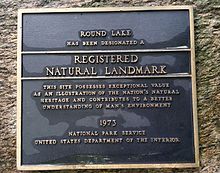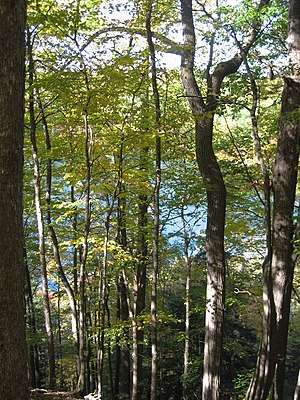Round Lake National Natural Landmark
Round Lake itself and the adjoining 59 acres (24 ha) of old-growth forest were designated a National Natural Landmark in 1973 by the U.S. Department of the Interior.
Vogelmann's evaluation noted the "outstanding virgin mesophytic forest" adjoining Round Lake on its southwestern side; this text became part of the citation when the landmark was created.
The virgin quality of the forest near Round Lake was already considered unusual in 1855, when Ledyard Lincklaen noted that this "dense body of woodland had hardly felt the axe.
One of these descendants, Betsy Knapp, wrote a memoir Rocks, Fields and Beauty Forever: One Family's Memories of Fayetteville's Green Lakes[8] in 1989.
The old-growth forestlands throughout Green Lakes State Park were extensively surveyed in 2001-2002 by members of the Wildwood Ancient Forest Alliance.
Green Lakes State Park contains particularly old and large examples of tuliptrees, sugar maples, beech, basswood, hemlocks, and white cedars.
Because the deep, oxygen-depleted bottoms of the lakes are undisturbed either by annual mixing or by "bioturbation" (plant growth or movement of worms and other animals), each year's sediments are preserved as distinguishable layers (or varves) that can be dated back in time from the present.



